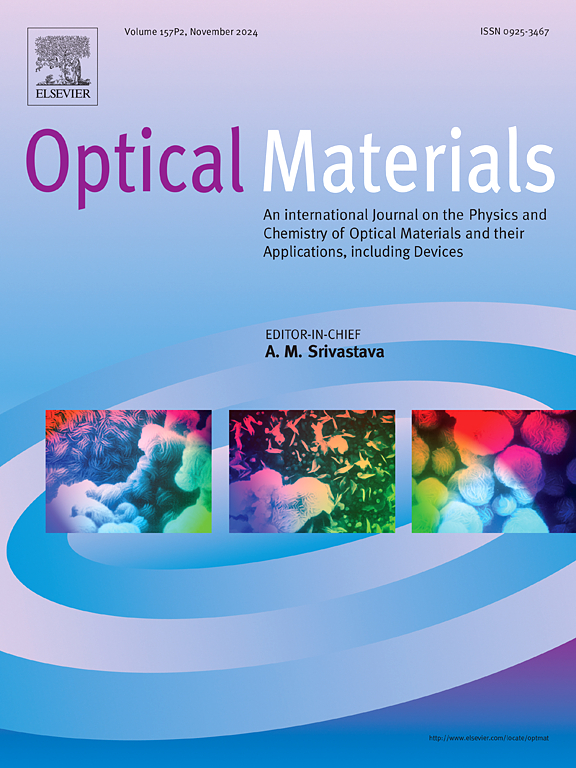增强羧甲基纤维素薄膜的发光和机械性能:甘油在镧系化合物掺入中的作用
IF 3.8
3区 材料科学
Q2 MATERIALS SCIENCE, MULTIDISCIPLINARY
引用次数: 0
摘要
通过在增塑羧甲基纤维素(CMC)薄膜上固定镧系离子络合物来开发柔性发光材料是一项重大挑战。本研究以不同量的甘油为增塑剂,采用铸造技术沉积合成了[Eu(tta)3(H2O)2]和[Tb(acac)3(H2O)3]配合物的CMC薄膜。所得薄膜表现出非晶态特性和高达约245°C的热稳定性。光致发光研究表明,由于天线效应,在352 nm激发下,含有Eu3+配合物的薄膜在红色区域(614 nm)显示出强烈的发射。值得注意的是,与原始复合物(分别为0.22 ms和24%)相比,增塑剂浓度最高的CMC_Eu_20.0 GLY膜的实验寿命(0.69 ms)和量子效率(39% q (5D0))显著提高。含Tb3+配合物的薄膜在300 nm处激发时,在546 nm处表现出较强的绿色发射。随着甘油含量的增加,观察到激发寿命的增加,在甘油浓度为15%时达到最大值1.50 ms。增塑剂含量对薄膜的力学性能有显著影响。20%甘油的加入使断裂伸长率从8.9%大幅提高到39.5%。然而,它也增加了弹性,降低了牵引阻力,杨氏模量从3.4降至1.5 MPa,断裂应力从12.4降至5.6 MPa。有趣的是,镧系配合物的掺入并没有显著影响薄膜的力学性能。这一发现表明,发光特性可以独立于机械特性进行定制,为各种应用的材料设计提供了多功能性。本文章由计算机程序翻译,如有差异,请以英文原文为准。

Enhancing luminescent and mechanical properties of carboxymethylcellulose films: The role of glycerol in lanthanide complex incorporation
Developing flexible luminescent materials through immobilizing lanthanide ion complexes in plasticized carboxymethylcellulose (CMC) films presents a significant challenge. This study focused on the synthesis of CMC films incorporating [Eu(tta)3(H2O)2] and [Tb(acac)3(H2O)3] complexes, with varying amounts of glycerol as a plasticizer, using casting technique deposition. The resulting films exhibited amorphous characteristics and thermal stability up to approximately 245 °C. Photoluminescence studies revealed that films containing the Eu3+ complex displayed intense emission in the red region (614 nm) when excited at 352 nm, attributed to the antenna effect. Notably, the CMC_Eu_20.0 GLY film, with the highest concentration of plasticizer, showed significant enhancements in experimental lifetime (0.69 ms) and quantum efficiency (39 % q (5D0)) compared to the pristine complex (0.22 ms and 24 %, respectively). Films containing the Tb3+ complex, when excited at 300 nm, exhibited strong emission in the green region at 546 nm. An increase in excited lifetime was observed with increasing glycerol content, reaching a maximum of 1.50 ms at 15 % glycerol concentration. The mechanical properties of the films were significantly influenced by plasticizer content. The addition of 20 % glycerol resulted in a substantial increase in elongation at break from 8.9 % to 39.5 %. However, it also led to increased flexibility and reduced traction resistance, as evidenced by the decrease in Young's modulus from 3.4 to 1.5 MPa and breaking stress from 12.4 to 5.6 MPa. Interestingly, the incorporation of lanthanide complexes did not significantly affect the mechanical properties of the films. This finding suggests that luminescent properties can be tailored independently of the mechanical characteristics, offering versatility in material design for various applications.
求助全文
通过发布文献求助,成功后即可免费获取论文全文。
去求助
来源期刊

Optical Materials
工程技术-材料科学:综合
CiteScore
6.60
自引率
12.80%
发文量
1265
审稿时长
38 days
期刊介绍:
Optical Materials has an open access mirror journal Optical Materials: X, sharing the same aims and scope, editorial team, submission system and rigorous peer review.
The purpose of Optical Materials is to provide a means of communication and technology transfer between researchers who are interested in materials for potential device applications. The journal publishes original papers and review articles on the design, synthesis, characterisation and applications of optical materials.
OPTICAL MATERIALS focuses on:
• Optical Properties of Material Systems;
• The Materials Aspects of Optical Phenomena;
• The Materials Aspects of Devices and Applications.
Authors can submit separate research elements describing their data to Data in Brief and methods to Methods X.
 求助内容:
求助内容: 应助结果提醒方式:
应助结果提醒方式:


